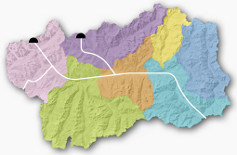Aosta: the sacred paths
How: by foot.
Recommended duration: half a day.
Recommended period: all year round.
Distance: around 2 km.
An unusual journey to discover the oldest and most important places of worship of the city, meandering between small and narrow ‘secret’ streets, orchards, gardens and ancient walls…
The route departs from the ancient heart of the city: the Praetorian Gate, on the north side of which stands the imposing Torre dei Signori of the Porta Sant’Orso which indicates the entrance into the medieval Village of Sant’Orso. From here, take Via Sant’Anselmo and, after a few metres, turn left in the direction of “Collegiate Church of the Saints Pietro and Orso”:/en/database/8/churches-and-sanctuaries/aosta/collegiate-church-and-cloister-of-sant-orso/720; a place brimming with history and mysticism, the church has its origins in the Paleochristian age and has always represented a symbol of Aosta Valley religion. A funerary church preferred for centuries by powerful nobilities, Sant’Orso contains real treasures of Christian archaeology and art history. The famous Magic square can also be found here: an elegant square mosaic rug dating back to the 11th – 12th century and brought back to light by archaeological digs conducted in 1999, still considered full of mystery. The church also contains another treasure: the magnificent cycle of frescoes in the loft, dating back to the Ottonian age (beginning of 11th century AD) which remained hidden for centuries following the construction of a false ceiling at the end of the 15th century. Next to the church is the wonderful Romanesque cloister which, with its 40 stained marble capitals, draws crowds of students and visitors each year.
On the left of the churchyard, coming out of the cloister, is the beautiful renaissance Priory with its refined and unusual mullioned windows carved out of clay, so desired by the prior Giorgio of Challant at the end of the 15th century.
On the right stands the powerful Romanesque bell tower, originally a defensive tower, as demonstrated by the especially high position of the entrance door on the east side.
Finally, the nearby church of San Lorenzo, under the its late-gothic appearance, hides Paleochristian origins (beginning of 5th century AD); the tombs of important bishops of Aosta were discovered here among which Grato (patron saint of the diocese), which can all be dated between the second half of the 5th and 6th century AD. On the left of the current church, a path leads to the underground archaeological area.
Continuing now along Via Sant’Orso which leads to a rural area, made up of orchards and gardens: here stands the ancient monumental cemetery of the village of Sant’Orso, where many important figures of Aosta Valley culture, science and politics rest.
Turning left, we reach the north-east corner of the Roman Aosta walls, highlighted by the powerful square tower of the Balivi. Over the centuries, the square tower transformed into a complex which, from the urban residence of the De Palatio noble family, become the headquarters of the ‘balivi’, representatives of the duke of Savoy and administrators of justice. From 1430 to 1984, this was the location of the city prisons and today, after a decade-long restoration effort, it will host the Regional musical institute. The north face of the building, attached to the Roman walls, accompanies us along Via Guido Rey until the breach which, on the left, allows us to get nearer to the Santa Caterina Convent, founded in 13th century, inside of which stands the ruins of the Roman amphitheatre of Augusta Praetoria. The entrance to the convent is emphasized by a precious fresco from the end of the 15th century; emerging beyond the wall is the small but elegant bell tower of the convent chapel which dates back to the 13th century.
Crossing Via Xavier de Maistre, you then take Via San Giocondo (formerly rue des Prêtres): here you really feel like you are in the countryside with the low historic buildings and the fruit trees. Since the Middle Ages, this path has marked the access to the ecclesiastical quarter where the right of asylum was enjoyed, and which corresponded to the area today bounded by Via Abbé Chanoux (to the north, parallel to Via San Giocondo), Piazza Roncas (to the west), Via De Sales (to the south) and finally Via Xavier de Maistre (to the east). Along this path, up until 1808, the procession des Immunités took place.
Once in piazza Roncas you will find yourself in front of the Palazzo Roncas: now under restoration, this building represents one of the most elegant houses of the sixteenth century in the city and is further embellished with beautiful frescoes and ‘grotesques’ created between the end of the 16th and the beginning of the 17th century.
The opposite building, today the premises of the MAR – Regional Archaeological Musem, was the property of the noble Vaudan family and hosted the Visitation monastic order.
In 1802, the sisters of the Visitation had to leave the monastery upon the orders of Napoleon and thus the convent was converted into barracks called Caserne René de Challant.
Before proceeding along the route of the procession ’des Immunités’, a short detour is imperative: from piazza Roncas take Via Martinet; after a few metres on the right, a passage opens up that leads onto the court yard of the church of Santo Stefano, nestled in a corner almost hidden just outside the ancient walls in an area originally occupied by a necropolis. Simple in form but rich in history, the church of Santo Stefano possesses a precious frescoed facade dating back to the mid 1700s and has reused many architectural elements from the Roman age.
Retracing our steps and meandering along Via Forum, we find the current square of the cathedral which, in practice, is similar to the original sacred terrace of the court, the official place of worship of the colony. From the cathedral square, take Via De Sales and go right for a few metres; a little further on, on the left, take the narrow Via Lostan. Despite appearances, this alleyway holds many interesting aspects: it takes its name from the Lostan nobilities who had their palace here, still recognizable, though currently in restoration, thanks to the two typically seventeenth century lowered arcades characterized by the inner courtyard.
This then leads us to Via De Tillier, to the point in which the church of San Grato stands, today deconsecrated and used as an exhibition venue, but originally a real cornerstone of the most heartfelt celebrations of the citizens. Despite its small size from the 19th century alterations, the chapel, which has existed at least from the beginning of the 13th century, was originally larger and probably had the canonical east-west orientation. From here we continue towards piazza Deffeyes where the Palazzo dell’Amministrazione Regionale stands, built on the foundations of the previous Mauritian hospital, founded in 1173.
Turning left and following Via Festaz, you will arrive in the vicinity of the church, in the area once occupied by the Priory of Saint-Bénin with the annexed male college, one of the most popular of the Savoy states. Then travelling along Viale Conseil des Commis formally piazza Chanoux, you would never image that, where today you find the monumental Hôtel de Ville (town hall), up until the end of the 18th century there stood one of the biggest and most beautiful gothic churches in the north-east of Italy, part of the convent of St. Francis, constructed in 1352 by Amedeo VI of Savoy. Initially transformed into barracks, in 1836 the convent was completely destroyed in order to build the modern neoclassical town hall; only a ten-sided gothic chapel now remains, incorporated into Caffè Nazionale.













